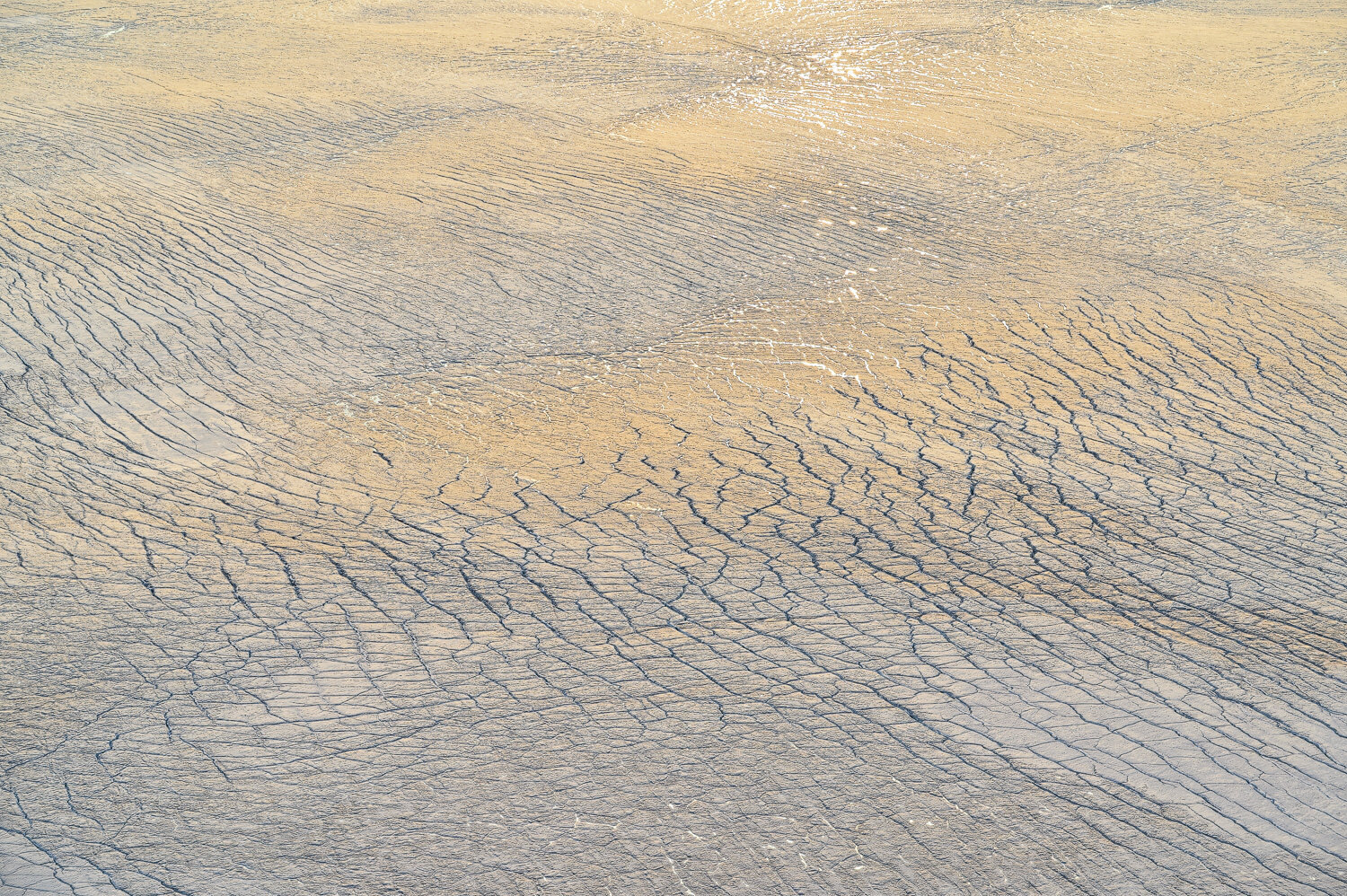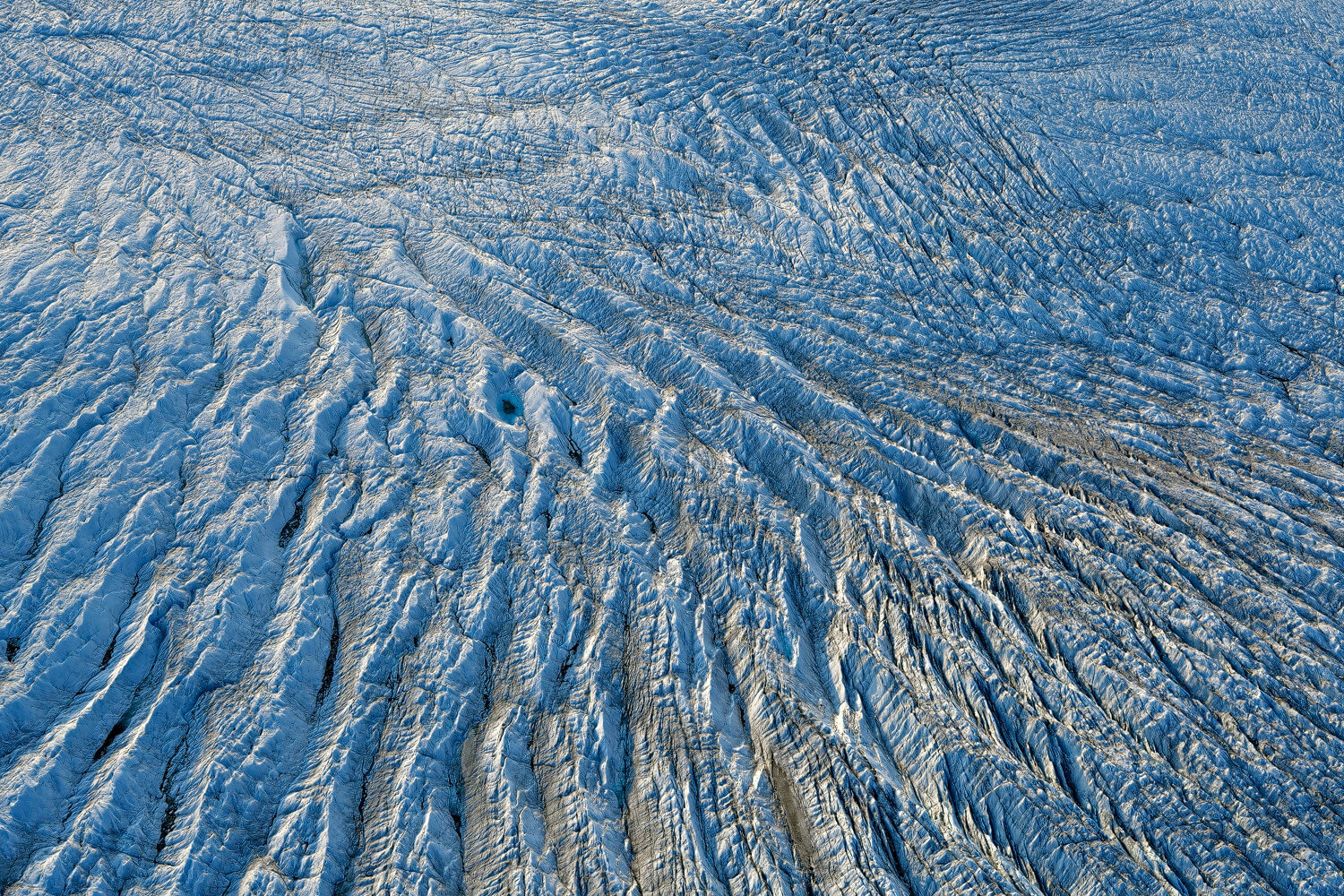What does the collection show?
An artistic aerial photography project that focuses on the opulent blue tones of the meltwater lakes on the Greenlandic ice sheet.
The eccentric series of images is rounded off by studies of the surface of the ice sheet taken from the air.
There are motifs that are to be be found outside the creative process on a material level in such a complex field of tension that one hardly dares to dream of their exploration.
Year after year the same natural spectacle takes place on the Greenlandic ice sheet. As soon as summer approaches, large meltwater lakes form at the edge of this huge ice desert, which is about five times the size of Germany. These will be drained by a network of streams, rivers and rivers flowing towards the sea. The lakes will disappear again as soon as it gets colder - either through continuous runoff or by opening siphons deep into the crevices and crevices of the ice - which often leads to almost sudden drainage. The water filters all spectral colours out of daylight until finally only shades of blue remain, which are scattered and reflected on the icy bottom of the lakes. Thus, physics causes these lakes to shine in an almost supernaturally intense blue, even though they are clear meltwater.
8 years ago, during a flight over the gigantic Kangia Icefjord near Ilulissat (Greenland), I was able for the to catch a glimpse of the blue of the summer meltwater lakes forming in the furrows of the most productive glacier in the northern hemisphere first time. This wonder of nature captivated me at once.
Shortly afterwards, during a transit flight, I saw that about 50 km inland on the edges of the Greenlandic ice sheet, much larger lakes had formed. But from the perspective of the high-flying commercial aircraft I was unable to pick up more than a handful of abstract interpretations of the subject.
I made several flights in small planes in Greenland in the following years, but I never got anywhere near those lakes. They are much too far off the beaten track of classic "sightseeing" flight routes. Nevertheless, there were a few lucky encounters with blue shimmering waters at the glaciers, but never intensive enough for serious photographic project work. Only a particularly long flight in 2016 brought me close to these lakes - but since it was not an exclusively private flight, my possibilities remained limited.
Through the experience gained on these flights, the limits and pitfalls of the subject were clearer than ever before. While up to now I had only paid attention to the mere (seasonal) presence of the lakes, the weather and the light, I also got to know another factor that was essential for success, namely the skills of the pilot. If the communication between photographer and pilot does not work and the pilot subsequently fails to anticipate the optimal approach angle for the photographer, even a flight under otherwise perfect conditions can remain without significant results - after all, what good is it if the subject is located at a barely accessible angle under the aircraft at the moment of the fly-by?
Under the premise that for me as a self-financed photo artist only acting under perfect conditions would justify the cost risk of a 100% individually arranged flight - I had to wait for the next opportunity. The weather was promising, the light was dominated by wonderful afternoon sunshine. And already during the flight from Ilulissat to Kangerlussuaq I saw some blue dots on the ice far on the horizon - "they" were there.
Arriving in Kangerlussuaq, it turned out that at that time a young female pilot was on duty there with the small plane. After just a short conversation, a positive impression was already established - I had the feeling that she could understand what I had photographically in mind. A brief inspection of the aircraft and the deal was done. I invited my Greenlandic friend Adam to accompany me on the flight (he threw a few hundred Danish Kroner into the pot to buy us a few extra minutes in the air) - and half an hour later we were ready for take-off on the tarmac.
One shot, one opportunity
Perfect light, perfect weather - now it was important not to make a mistake. I used the experience of all my flights: avoiding vibrations, optimal exposure times, changing light situations: everything had to fit perfectly. A 90-minute flight was planned, with approach and return flight I would hardly have an hour over the ice.
I noticed that above the inland ice both engines failed and that my friend Adam was sitting behind me only stiff as a stick, while the pilot tried with fast, concentrated movements to get the machines running again. It was only a side note for me in that moment. I just kept on photographing. When the engines were running again the pilot explained that due to our constant right turns the fuel had flowed to one side so that the engines could no longer suck in fuel. We should now fly a left turn after every third right turn to distribute the fuel in the tank - this was o.K. for me. - as long as we kept circling the lakes with the same precision.
Rarely have I managed to put my rational thinking in the background to such an extent and to shift my actions completely to my intuition. Seeing, anticipating, shaping and pulling the trigger - on this flight, all this was no longer a consciously controlled process. Working with the colors and shapes, through the constantly moving airplane, one moment more fleeting than the other: for every picture there was exactly one opportunity of the duration of one blink of the eye, because even a renewed approach from the same direction did not allow the reproduction of a missed situation.




























